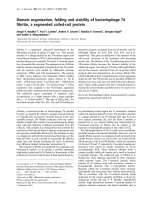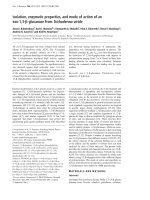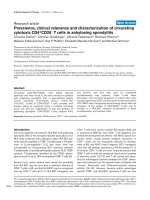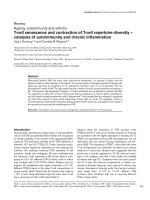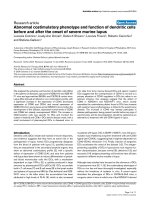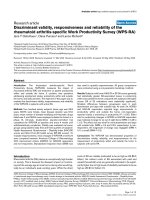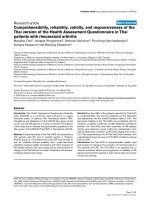Báo cáo y học: "Improving calculation, interpretation and communication of familial colorectal cancer risk: Protocol for a randomized controlled trial" pot
Bạn đang xem bản rút gọn của tài liệu. Xem và tải ngay bản đầy đủ của tài liệu tại đây (599.12 KB, 7 trang )
STUD Y PROT O C O L Open Access
Improving calculation, interpretation and
communication of familial colorectal cancer risk:
Protocol for a randomized controlled trial
Nicky Dekker
1,2
, Rosella PMG Hermens
2*
, Glyn Elwyn
3
, Trudy van der Weijden
4
, Fokko M Nagengast
5
,
Peter van Duijvendijk
6
, Simone Salemink
1
, Eddy Adang
7
, J Han JM van Krieken
8
, Marjolijn JL Ligtenberg
1,8
,
Nicoline Hoogerbrugge
1,9
Abstract
Background: Individuals with multiple relatives with colorectal cancer (CRC) and/or a relative with early-onset CRC
have an increased risk of developing CRC. They are eligible for preventive measures, such as surveillance by regular
colonoscopy and/or genetic counselling. Currently, most at-risk individuals do not follow the indicated follow-up
policy. In a new guideline on familial and hereditary CRC, clinicians have new tasks in calculating, interpreting, and
communicating familial CRC risk. This will lead to better recognition of individuals at an increased familial CRC risk,
enabling them to take effective preventive measures. This trial compares two implementation strategies (a
common versus an intensive implementation strategy), focussing on clinicians’ risk calculation, interpr etation, and
communication, as well as patients’ uptake of the indicated follow-up policy.
Methods: A clustered randomized controlled trial including an effect, process, and cost evaluation will be
conducted in eighteen hospitals. Nine hospitals in the control group will receive the common implementation
strategy (i.e., dissemination of the guideline). In the intervention group, an intensive implementation strategy will
be introduced. Clinicians will receive education and tools for risk calculation, interpretation, and communication.
Patients will also receive these tools, in addition to patient decision aids. The effect evaluation includes assessment
of the number of patients for whom risk calculation, interpretation, and communication is performed correctly, and
the number of patients following the indicated follow-up policy. The actual exposure to the implementation
strategies and users’ experiences will be assessed in the process evaluation. In a cost evaluation, the costs of the
implementation strategies will be determined.
Discussion: The results of this study will help determine the most effective method as well as the costs of
improving the recognition of individuals at an increased familial CRC risk. It will provide insight into the
experiences of both patients and clinicians with these strategies.
The knowledge gathered in this study can be used to improve the recognition of familial and hereditary CRC at
both the national and international level, and will serve as an example to improve care for patients and their rela-
tives worldwide. Our results may also be use ful in improving healthcare in other diseases.
Trial registration: ClinicalTrials.gov NCT00929097
Background
The lif etime risk of developing colorectal cancer (CRC)
in Western society is 5 to 6%[1,2]. Familial and heredi-
tary cancers account for approximately 15 to 20% of all
CRCs [3-5]. In these families, healthy relatives of CRC
patients may have an increased risk of developing CRC
themselves. This so-called familial CRC risk can be
divided into three groups, based on cumulative lifetime
risks of developing CRC:
1. Average: familial CRC risk below 10%.
2. Moderate: familial CRC risk of 10-15%.
* Correspondence:
2
Scientific Institute for Quality of Healthcare, Radboud University Nijmegen
Medical Centre, Nijmegen, the Netherlands
Dekker et al. Implementation Science 2010, 5:6
/>Implementation
Science
© 2010 Dekker et al; licensee BioMed Central Ltd. This is an Open Access article distributed under the terms of the Creative Commons
Attribution License (http://c reativecommons.org/licenses/by/2.0), which permits unrestricted use, distr ibution, an d reproduction in
any medium, provided the original work is properly cited.
Figure 1 Intensive implementation strategy for the intervention group, aimed at both patient s and clinicians. The r hombuses in this
figure represent the tasks clinicians have in calculation, interpretation and communication of the familial colorectal cancer (CRC) risk in CRC
patients. It also shows the various elements of the intensive implementation strategy aimed at both patients and clinicians (in yellow and green,
respectively) that will be compared to dissemination of the guideline on familial and hereditary colorectal cancer only. Familial CRC risk:
cumulative lifetime risk of developing CRC for first-degree relatives of CRC patients.
Dekker et al. Implementation Science 2010, 5:6
/>Page 2 of 7
3. High: familial CRC risk above 15%.
For each group, a different follow-up policy applies.
For individuals with an average familial CRC risk,
neither surveillance nor genetic counselling is indicated.
For individuals with a moderate familial CRC risk, sur-
veillance by regular colonoscopy is indicated. For indivi-
duals with a high familial CRC risk, referral for genetic
counselling is recommended. Identi fication of indivi-
duals with an increased familial CRC risk is crucial
because surveillance significantly reduces CRC-related
morbidity and mortality, by 43 to 80% and 65 to 81%,
respectively[6,7]. Both underuse and overuse of surveil-
lance and genetic counselling have a significant impact
on patients and their relatives, and may lead to unneces-
sary costs.
Familial CRC risk is assessed by family history and, in a
subset of patients, microsatellite instab ility (MSI) analysis
performed by pathologists. Unfortunately, both proce-
dures are difficult. Previous research has shown that
patient family history often is missing or incomplete, and
information provided by patients is not always accurate
[4,8-11]. Furthermore, interpretation of the family history
(determining the indicated follow-up policy) is not always
correct[12]. Pathologists’ selection of patients for MSI is
often incomplete, while clinicians regularly interpret the
results incorrectly [Overbeek LI, Hermens RP, van Krie-
ken JH, Adang E, Casparie M, Akkermans R, Nagengast
FM, Ligtenberg MJ, Hoogerbrugge N. A tailored imple-
mentation strateg y increases involvement of patholog ists
in the recognition of patients at risk for Lynch syndrome:
cluster randomised controlled trial, submitted] Conse-
quently, only 12 to 30% of CRC patients with a high
familial CRC risk are referred for genetic counselling
[4,10,13-15]. Other studies have shown that many CRC
patients referred to a familial cancer clinic belong to an
average or m oderate risk population for whom genetic
counselling is not indicated[16,17].
Clinicians involved in the care for CRC patients recog-
nize th e need for improvement in this area. Therefore, a
multidisciplinar y evidence-based guideline on familial
and hereditary colorectal cancer (FHCC) was launched
in the Netherlands in 2008[18]. An important addition
compared to previous national and international g uide-
linesisthatsurgeonsandgastroenterologists (referred
to as ‘clinicians’ in this protocol) have new tasks in cal-
culating, interpretating, and communicating familial
CRC risk. Because clinicians are often unfamiliar with
these tasks, implementation strategies are needed to
ensure that patients and their relatives receive proper
counselling and follow-up[14]. In a previous trial, an
electr onic reminder system specifically aimed at pathol-
ogists improved completeness of patient selection for
MSI testing [Overbeek LI, Hermens RP, van Krieken JH,
Adang E, Casparie M, Akkermans R, Nagengast FM,
Ligtenberg MJ, Hoogerbrugge N. A tailored implemen-
tation strategy increases involvement of pathologists in
the recognition of patients at risk for Lynch syndrome:
cluster randomised controlled trial, submitted] In this
trial, we will provide support at both clinician and
patient level to further implement the guideline.
This trial compares two implementation strategies: a
common strategy (i.e., dissemination of the guideline)
versus an intensive implementation strategy, focussing
on clinicians’ risk calculation, interpretation, and com-
munication, as well as patien ts’ uptake of the indicated
follow-up policy.
An effect, process, and cost evaluation will be per-
formed. The improvement of the identification and
referral of patients at an increased familial CRC risk will
lead to a higher number of individuals following an
appropriate surveillance program, thereby reducing
CRC-related morbidity and mortality.
Methods
Study design and setting
A clustered randomized controlled trial including an
effect, process, and cost evaluation will be conducted in
eighteen community hospita ls. All patients with CRC
diagnosed under the age of 70 ye ars and their clinicians
will be invited to participate. To preve nt contamination
bias, randomization will take place at hospital level.
Stratification will take place according to hospital size
(<500, 500 to 700, and >700 beds), and be performed by
means of a computerized randomization system. This
study was approved by the Committee on Research
Involving Human Subjects of the region Arnhem-
Nijmegen.
Primary objectives
This trial compares two implementation strategies: a
common strategy versus an intensive implementation
strategy, focussing on clinicians’ risk calculation, i nter-
pretation, and communication, as well as patients’
uptake of the indicated follow-up policy.
Hypothesis
Providing patients and clinicians with information o n
CRC, a risk assessment tool, risk communication aids,
and decision aids will improve calculation, interpreta-
tion, and communication of the familial CRC risk by
clinicians, as well as patients’ uptake of the indicated
follow-up policy more than dissemination of the guide-
line only.
Outcome measures
Effect evaluation
1. The percentage of CRC patients for whom a correct
familial CRC risk is calculated by clinicians.
Dekker et al. Implementation Science 2010, 5:6
/>Page 3 of 7
2. The percentage of CRC patients for whom a calcu-
lated familial CRC risk is corr ectly inter preted by
clinicians.
3. The percentage of CRC patients with whom a cal-
culated familial CRC risk and/or follow-up policy is
communicated by clinicians.
4. Patients’ uptake of the indicated follow-up policy.
Process evaluation
1. Actual exposure to the different elements of the
implementation strategies.
2. The experiences of patients and clinicians with
these elements.
Cost evaluation
Costs of the implementation strategies in relation to the
number of correctly referred patients.
Participants
Clinicians from eighteen hospitals will participate. All
their patients diagnosed with CRC under the age of 70
years during the six-month inclusion period are eligible
for inclusion. Patients must be able to provide informed
consent and be able to read and understand Dutch.
Patients previously referred for genetic counselling for
CRC are excluded. Patients will be selected by PALGA
(Pathologisch-Anatomisch Landelijk Geautomatiseerd
Archief), the nationwide network and registry of histo-
and cytopathology in the Netherlands[19].
All patients will receive a patient information letter,
signed by their treating clinician, along with an
informed consent form. After signing the informed con-
sent form, they will be included in the study.
Interventions
Implementation strategies in both groups
In both the control group and the intervention group,
clinicians will receive the FHCC guideline.
Intensive implementation strategy in the intervention group
The intensive implementation strategy is summarized in
Figure 1 and consists of the following implementatio n
tools: a website for patients and clinicians; education for
clinicians; and a risk communication tool for clinicians.
Website
The website consists of the following items:
1. A summary of evidence-based and relevant infor-
mation about familial CRC risk (lifetime risk of devel-
oping CRC). Natural frequencies with the same
denominator and visual displays will be used. Absolute
risks will be presented, as well as in comparison to the
population risk. The outcomes are offered in both
positive and negative frames (e.g., the risk of develop-
ing CRC as well as the chance of not developing CRC).
The focus is on familial CRC risk and the different fol-
low-up policies. The information is presented in two
different formats, one for patients and one for
clinicians.
2. A risk assessment tool to calculate patien ts’ familial
CRC risk. Patients fill in medical i nformation about
themselves and their relatives with regard to CRC and
other cancers. Clinicians can use the tool as well. T he
calculated familial CRC risk is given in the same format
as the rest of the website. Advice for follow-up is offered
based on this risk, as well as a reminder to use the cor-
responding decision aid, if applicable.
3. Decision aids, aimed at facilitating decisions invol-
ving the uptake of the indicated follow-up policy (one
for surveillance and one for genetic counselling). Tools
supporting patients in making informed choices about
their healthcare, such as decision aids, have been
shown to improve knowledge, clarify preferences, and
reduce uncertainty around decision making, with high
levels of acceptability among consumers[20,21]. The
decision aids used in this trial provide balanced infor-
mation on different options, i.e., to be referred for sur-
veillance/genetic counselling or not. The following
items are addressed: background information, benefits
and harms, and the potential impact on the patient
and their relatives. Worksheets are provided for
patients to list and rate the importance of the benefits
and harms for themselves.
The website is available exclusiv ely to patients and
clinicians in the intervention group. A login name and
password will be provided upon inclusion. Patients can
use the website independently before or after regular
follow-up visits, and are encouraged to discuss the
results with their clinician. They are instructed to keep
the decision aid within their family, and not share it
for reasons of research integrity. To minimize contami-
nation bias, after the trial all patients in the control
group will be asked if they were exposed to the
website.
Education
In an educational meeting, clinicians in the intervention
group will be trained to use the FHCC guideline.
Risk communication tool
Clinicians will receive a tool for communicating the
familial CRC risk with their patients during a regular
fol low-up visit. The tool consists of written information
and visual displays of the population risk of CRC, an
explanation of the risk level of the patient and his/her
relatives, as well as the indicated follow-up policy. It is
designed in the same format as the website.
Development of the implementation tools
During development, the content and presentation of
the website and the risk communication tool w ill be
rev iewed by physicians not specifically trained in genet-
ics, and by non-medical personnel as well as representa-
tives from the Dutch CRC patient associations
(Vereniging HNPCC-Lynch and Stichting Doorgang).
Improvements will be made based on their comments.
Dekker et al. Implementation Science 2010, 5:6
/>Page 4 of 7
Before use, the tools will be tested among approximately
20 patients and 20 clinicians. The purpose of this pilot
is determining whether the website and the tools are
acceptable, the info rmation is presented clearly, and the
completion of the tools is feasible.
Power calculation
To detect a difference of 20% between the intervention
group and the control group in uptake of surveillance
by colonoscopy in pat ients at moderate familial CRC
risk, and r eferral for genetic counselling in patient s at a
high familial CRC risk, at least 186 patients are required
(alpha = 0 .05, a two-sided testing and power = 0.80).
However, considering an intracluster-correlation coeffi-
cient of 0.15 and an aver age of five patients per c lini-
cian, at least sixty clinicians and 300 patients are
needed. For eighteen hospitals this means three to four
clinicians and 15 to 20 patients per hospital.
Data collection
Baseline characteristics
Baseline characteristics from patients, clinicians, and
hospitals will be collected in the following manner:
1. Patients: From PALGA, data including age, gender,
and some medical information will be collected. Medical
information includes diagnoses of cancer (diagnosed
since 1971), cancer type, and age at diagnosis, as well as
the result of MSI testing. The following data will be col-
lected by a self-administered questionnaire: ethnicity,
current marital status, educational level, previous medi-
cal or health training, and family history of cancer (type
of cancer and age at diagnosis). Family history is col-
lected for first-degree relatives (i.e., parents, siblings, and
children).
2. Clinicians: All participating clinicians will be asked
to pro vide baseline data (e.g., specialization, number of
years of experience) in a questionnaire
3. Hospitals: From the hospitals’ websites, characteris-
tics such as size, teaching status, an d presence of an
outpatient department for genetic counselling will be
obtained.
Effect evaluation
Before introducing the implementation strategies, a
baseline assessment of risk ca lculation, interpretation,
and communication will be performed. Both the base-
line assessment and the evaluation of the implementa-
tion strategies will be performed retrospectively in the
same manner. Baseline characteristics will be collected
in the manner described above. The measuring instru-
ments will be developed by identifying all relevant
variables and translating these into questionnaires.
When possible, exist ing validated questionnaires will
be used.
The family histo ry as reported by the patient in the
questionnaire will be used to calculate a formal familial
CRC ris k and determine the indicated follow-up policy.
This will be compared to the family history taken by the
cli nician, alo ng wi th the risk calculation and interpreta-
tion performed by t he clinician. These data will be
extracted from the p atients’ medica l records. The medi-
cal records will also be used to determine the number
of patients with whom the familial CRC risk and corre-
sponding follow-up policy has been communicated. To
determine the number of referred patients who actually
visit a familial c ancer clinic, these clinics will be asked
to report whether these patients have visited. The
uptake of surveillance by colonoscopy by first-degree
relatives will be determined by asking the patients
whether their relatives are actually scre ened. Medical
records a nd results from the decision aids on the web-
site will be used to determine whether patients at an
increased risk who were not r eferred for surveillance or
geneticcounsellingwerenotreferredbecausetheyhad
chosen not to be referred or because it was not
discussed.
Process evaluation
In the process evaluation, data are collected on actual
exposure of patients and clinicians to the different ele-
ments of the implementation strategies, as well as their
experience with these elements:
1. Website: The website automatically records the fol-
lowing data when it is used: who used which elements;
how often did users visit the diff erent elements of the
website; and how long did it take to use the different
elements. By using questionnaires, users’ experiences
with the website will be ascertained.
2. Education: Attendance at the meetings will be
determined by keeping an attendance list. The duration
of the meeting s will be recorded. In addition, clinicians’
experience with the meetings will be ascertained by
using a questionnaire.
3. Risk communication tool: Patients and clinicians
will be asked whether the tool was used. Their experi-
ence with the tool will be measured using questionnaires
focussing on the perceived usefulness and usability of
the tool.
Cost evaluation
Costs accompanied with the development and imple-
mentation of the website and risk communication tool
willbeaccountedfor,aswellasthecostsfordissemi-
nation of the guideline. Clinicians will provide time
estimates to use the different elements. Costs will be
correlated to the number of correctly referred
patients.
Data analysis
Effect evaluation
To analyze the effectiveness of both implementation
strategies, descriptive statistics and multilevel analysis
Dekker et al. Implementation Science 2010, 5:6
/>Page 5 of 7
will be used. Patient, clinician, and hospital characteris-
tics will be included in the multilevel analysis, allowing
for correction of the effectiveness for probable differ-
ences in case mix between the different hospitals. The
statistical analyses will be performe d using SPSS version
16.0 for Windows.
The percentage of correctly referred patients is
defined as follows:
1. The perce ntage of p atients at an average familial
CRC risk who are not referred for surveillance or
genetic counselling.
2. The percentage of patients at a moderate familial
CRC risk who want to be referred and are referred f or
surveillance.
3. The percentage of patients at a moderate familial
CRCriskwhodonotwanttobereferredandarenot
referred for surveillance.
4. The percentage of patients at a high familial CRC
risk who want to be referred and are referred for genetic
counselling.
5. The percentage of patients at a high familial CRC
risk who do not want to be referred and are not referred
for genetic counselling but are referred for surveillance
if they opt for it.
6. The percentage of patients at a high familial CRC
risk who do not want to be referred and are not referred
for genetic counselling or surveillance.
Process evaluation
Frequencies and means are used to assess the actual
exposure of the patients and clinicians to the elements
of the implementation strategies and to assess their
experience with these elements. A multilevel regression
analysis will be applied to assess which elements of the
intensive implementation strategy were particularly asso-
ciated with effective implementation of the new FHCC
guideline.
Cost evaluation
The costs of implementation related resource use will be
calculated on a per patient basis. The costs of the use of
each element per correctly referred patient will be calcu-
lated. The costs of the intensive implementation strategy
will be compared to the costs of dissemination of the
guideline only.
Discussion
Objectives
The aim of this trial is to compare two implementa-
tion strategies: a common implementation strategy
(dissemination of the guideline only) versus an inten-
sive implementation strategy, focussing on clinicians’
risk calculation, interpretation, and communication, as
well as patients’ uptake of the indicated follow-up pol-
icy, such as referral for colonoscopy or genetic
counselling.
Strengths and weaknesses
To our knowledge, this is t he first study of an imple-
mentation strategy designed to improve the recognition
of patients’ familial CRC risk by addressing both
patients and their clinicians (surgeons and gastroenterol-
ogists). If the intensive implementation strategy is suc-
cessful, the elements (the website and the risk
communication tool) can be released for general use by
patients and clinicians. They may also serve as an exam-
ple for other hereditary and non-hereditary diseases.
Our study will add knowledge to the effectiveness of
patient decision aids and the best w ay of supplying
patients and clinicians with information on disease risks.
Some limitations need to be addressed. Family history
as reported by the clinician will be compared to the
family history reported by the patient in a self-adminis-
tered questionnaire. Previous research has shown that
the accuracy of family history of CRC in first-degree
relatives reported by patients is approximately 90%[22].
The optimal way of ensuring that the family history
reported by the patient is accurate is by reviewing medi-
cal records of the affected relatives. Since written per-
missionfromrelativesisneededtodoso,thisisnot
feasible and will therefore not be done in this study.
In our evaluation, only patients will be included; their
relatives are not. Patients will be asked whether their
relatives are screened, but the relatives will not be con-
tacted to assess whether they actually received the
results from the risk assessment and the mat ching
advice.
Measurements may be c ontaminated in c ase others
are provided with the login code for the website.
Collecting data from medical records does not moni-
tor everything that is discussed between the clinician
and the patient. This may lead to underestimation of
the risk interpretation and communication. Videotaping
the c onsultations would shed light on the content and
quality of the risk communication, but would also influ-
ence the intervention by reminding the clinician of the
intervention. In this study, regular clinical practice will
be left undisturbed as much as possible.
Implications
The results of this study will help determine the most
effective way of improving the recognition of individuals
at an increased f amilial CRC risk. It will provide insight
into the experiences of both patients and clinicians with
these strategies.
This is important because many people are currently
not treated according to evidence-based guidelines, and
can benefit from proper cancer risk assessment and
appropriate follow-up, which has been proven to reduc e
morbidity and mortality. The knowledge gathered in
this study may improve the recognition of familial and
Dekker et al. Implementation Science 2010, 5:6
/>Page 6 of 7
hereditary CRC at national and international level and
serve as an example to improve care for patients and
their relatives worldwide. In addition, our results may be
useful in improving healthcare in other diseases.
Acknowledgements
This study is supported by a grant from ZonMw - the Netherlands
Organization for Health Research and Development (no. 80-82315-98-09005).
Ethics
This study was approved by the Committee on Research Involving Human
Subjects of the region Arnhem-Nijmegen (ABR no. NL25311.091.08).
Author details
1
Department of Human Genetics, Radboud University Nijmegen Medical
Centre, Nijmegen, the Netherlands.
2
Scientific Institute for Quality of
Healthcare, Radboud University Nijmegen Medical Centre, Nijmegen, the
Netherlands.
3
Department of Primary Care and Public Health, Cardiff
University, Cardiff, UK.
4
Department of General Practice, CAPHRI School for
Public Health and Primary Care, Maastricht University, Maastricht, the
Netherlands.
5
Department of Gastroenterology, Radboud University
Nijmegen Medical Centre, Nijmegen, the Netherlands.
6
Department of
Surgery, Radboud University Nijmegen Medical Centre, Nijmegen, the
Netherlands.
7
Department of Epidemiology, Biostatistics and HTA
assessment, Radboud University Nijmegen Medical Centre, Nijmegen, the
Netherlands.
8
Department of Pathology, Radboud University Nijmegen
Medical Centre, Nijmegen, the Netherlands.
9
Department of Medical
Oncology, Radboud University Nijmegen Medical Centre, Nijmegen, the
Netherlands.
Authors’ contributions
ND drafted the protocol, created the intervention materials, and is involved
in the implementation, analysis, and reporting aspects of the study. NH and
RH, the project leaders, conceived, designed, and obtained funding for the
study and are involved in all aspects of the study. GE and TvdW advised the
project team on shared decision making. HvK, FN, PvD, EA and ML
participated in designing the study. SS provided content expertise for the
intervention materials. EA provided advice on the economic evaluation. All
authors have read and approved the final manuscript.
Competing interests
The authors declare that they have no competing interests.
Received: 11 November 2009
Accepted: 28 January 2010 Published: 28 January 2010
References
1. The Netherlands Cancer Registry and Statistics 1999-2003. Netherlands
2003.
2. Jemal A, Siegel R, Ward E, Hao Y, Xu J, Thun MJ: Cancer statistics, 2009. CA
Cancer J Clin 2009, 59:225-249.
3. Lynch HT, de la Chapelle A: Hereditary colorectal cancer. N Engl J Med
2003, 348:919-932.
4. Grover S, Stoffel EM, Bussone L, Tschoegl E, Syngal S: Physician assessment
of family cancer history and referral for genetic evaluation in colorectal
cancer patients. Clin Gastroenterol Hepatol 2004, 2:813-819.
5. de Jong AE, Vasen HF: The frequency of a positive family history for
colorectal cancer: a population-based study in the Netherlands. Neth J
Med 2006, 64:367-370.
6. Dove-Edwin I, Sasieni P, Adams J, Thomas HJ: Prevention of colorectal
cancer by colonoscopic surveillance in individuals with a family history
of colorectal cancer: 16 year, prospective, follow-up study. BMJ 2005,
331:1047.
7. Jarvinen HJ, Aarnio M, Mustonen H, Aktan-Collan K, Aaltonen LA,
Peltomaki P, de la Chapelle A, Mecklin JP: Controlled 15-year trial on
screening for colorectal cancer in families with hereditary nonpolyposis
colorectal cancer. Gastroenterology 2000, 118:829-834.
8. Sijmons RH, Boonstra AE, Reefhuis J, Hordijk-Hos JM, de Walle HE,
Oosterwijk JC, Cornel MC: Accuracy of family history of cancer: clinical
genetic implications. Eur J Hum Genet 2000, 8:181-186.
9. Church J, McGannon E: Family history of colorectal cancer: how often
and how accurately is it recorded?. Dis Colon Rectum 2000, 43:1540-1544.
10. Foo W, Young JM, Solomon MJ, Wright CM: Family history? The forgotten
question in high-risk colorectal cancer patients. Colorectal Dis 2009,
11:450-455.
11. Ruo L, Cellini C, La-Calle JP Jr, Murray M, Thaler HT, Quan SH, Guillem JG:
Limitations of family cancer history assessment at initial surgical
consultation. Dis Colon Rectum 2001, 44:98-103.
12. Alberto VO, Harocopos CJ, Patel AA, Clark SK: Family and personal history
in colorectal cancer patients: what are we missing?. Colorectal Dis 2006,
8:612-614.
13. van Dijk DA, Oostindier MJ, Kloosterman-Boele WM, Krijnen P, Vasen HF:
Family history is neglected in the work-up of patients with colorectal
cancer: a quality assessment using cancer registry data. Fam Cancer
2007, 6:131-134.
14. Overbeek LI, Hoogerbrugge N, van Krieken JH, Nagengast FM, Ruers TJ,
Ligtenberg MJ, Hermens RP: Most patients with colorectal tumors at
young age do not visit a cancer genetics clinic. Dis Colon Rectum 2008,
51:1249-1254.
15. Staal-Rosier PM, Rabeling-Keus IM, Kruyt M: [Inadequate referral for genetic
evaluations of patients with colorectal carcinoma]. Ned Tijdschr Geneeskd
2009,
153:124-128.
16. Mak T, Speake D, Lalloo F, Hill J, Evans DG: Familial colorectal cancer
referral to regional genetics department–a single centre experience.
Fam Cancer 2007, 6:81-87.
17. Williams GL, Gray J, Beynon J: Cancer genetics clinics and the surgeon: a
valuable role for family history screening. Ann R Coll Surg Engl 2007,
89:127-129.
18. Dutch Society for Clinical Genetics: CBO Guideline Hereditary Colorectal
Cancer, 2008. . Oisterwijk 2008.
19. Casparie M, Tiebosch AT, Burger G, Blauwgeers H, Pol van de A, van
Krieken JH, Meijer GA: Pathology databanking and biobanking in The
Netherlands, a central role for PALGA, the nationwide histopathology
and cytopathology data network and archive. Cell Oncol 2007, 29:19-24.
20. Barratt A, Trevena L, Davey HM, McCaffery K: Use of decision aids to
support informed choices about screening. BMJ 2004, 329:507-510.
21. O’Connor AM, Stacey D, Entwistle V, Llewellyn-Thomas H, Rovner D,
Holmes-Rovner M, Tait V, Tetroe J, Fiset V, Barry M, et al: Decision aids for
people facing health treatment or screening decisions. Cochrane
Database Syst Rev 2003, CD001431.
22. Ziogas A, Anton-Culver H: Validation of family history data in cancer
family registries. Am J Prev Med 2003, 24:190-198.
doi:10.1186/1748-5908-5-6
Cite this article as: Dekker et al.: Improving calculation, interpretation
and communication of familial colorectal cancer risk: Protocol for a
randomized controlled trial. Implementation Science 2010 5:6.
Submit your next manuscript to BioMed Central
and take full advantage of:
• Convenient online submission
• Thorough peer review
• No space constraints or color figure charges
• Immediate publication on acceptance
• Inclusion in PubMed, CAS, Scopus and Google Scholar
• Research which is freely available for redistribution
Submit your manuscript at
www.biomedcentral.com/submit
Dekker et al. Implementation Science 2010, 5:6
/>Page 7 of 7


